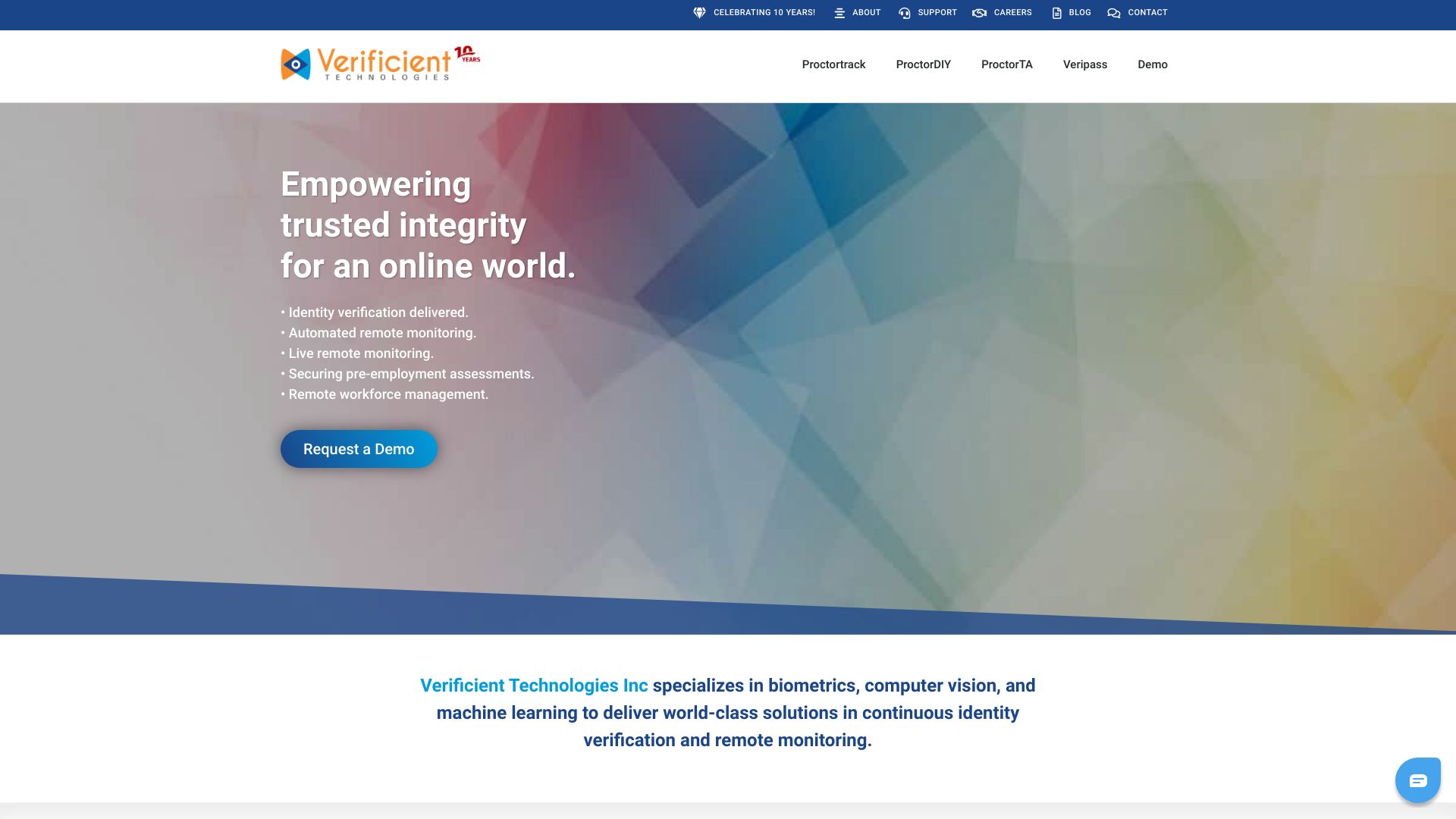- Home
- AI Face Recognition
- verificient

verificient
Open Website-
Tool Introduction:ID checks, proctoring, and browser lock for exam integrity.
-
Inclusion Date:Nov 06, 2025
-
Social Media & Email:
Tool Information
What is verificient AI
verificient AI is a suite of digital identity verification and remote proctoring solutions from Verificient Technologies. Powered by biometrics, computer vision, and machine learning, it helps schools and organizations protect exam integrity and authenticate test-takers at scale. The platform blends automated AI exam monitoring with options for live oversight and an in-class browser lock, verifying identities against a baseline profile and flagging suspicious activity. Its privacy-first design supports secure data handling, policy-driven retention, and transparent review workflows.
Main Features of verificient AI
- Biometric identity verification: Establishes a baseline profile and verifies test-takers before and during assessments.
- AI-powered remote proctoring: Uses computer vision to detect anomalies and potential misconduct in real time.
- Live and automated modes: Choose 100% automated monitoring, live proctor review, or a hybrid approach to fit risk levels.
- In-class browser lock (ProctorTA): Restricts navigation, blocks copy/paste, and reduces access to unauthorized resources.
- DIY live proctoring for K–12 (ProctorDIY): Lightweight workflows designed with student privacy and data security in mind.
- Data integrity with Veripass: Compares exam data to the baseline profile to confirm authenticity.
- Session reports and evidence: Risk scoring, timeline events, and recordings streamline post-exam reviews.
- LMS-friendly workflows: Supports integration with common learning platforms and standard assessment tools.
- Scalable exam security: Handles high-volume, high-stakes online assessments reliably.
- Privacy controls: Configurable retention policies and role-based access help align with institutional requirements.
Who Can Use verificient AI
verificient AI suits higher education institutions running high-stakes online exams, K–12 schools needing simple, secure monitoring, and certification and licensing bodies that require strict identity verification. It also supports corporate learning and development teams delivering compliance training and skills assessments, testing providers seeking scalable AI proctoring, and hybrid or fully online programs that must balance exam security with student privacy and accessibility.
How to Use verificient AI
- Set up your organization and connect your LMS or assessment platform if needed.
- Create a baseline identity profile for each test-taker via ID check and biometric capture.
- Select the proctoring mode: automated AI, live proctoring, or hybrid, based on exam risk.
- Configure restrictions, including browser lockdown settings and permitted resources.
- Publish exam instructions, equipment requirements, and privacy notices to candidates.
- Launch the exam; the system verifies identity and monitors behavior in real time.
- Review session data, flags, and evidence; escalate to manual review if necessary.
- Export results, analytics, and reports; apply your data retention policy.
verificient AI Use Cases
Universities use verificient AI to secure midterms and finals in learning platforms, verifying student identities and deterring cheating in remote settings. K–12 districts adopt ProctorDIY for supervised quizzes with streamlined privacy controls. Professional boards rely on biometric checks and AI monitoring to validate candidate authenticity for licenses and certifications. Corporate L&D teams leverage browser lock and automated proctoring to protect compliance assessments for distributed workforces.
Pros and Cons of verificient AI
Pros:
- Comprehensive exam security with biometric verification and AI monitoring.
- Flexible modes: automated, live, and hybrid proctoring options.
- In-class browser lock reduces access to unauthorized resources.
- Privacy-forward features and configurable data retention.
- Actionable reports and evidence for efficient academic review.
- Works at scale for high-stakes, high-volume assessments.
Cons:
- Requires webcam, microphone, and stable internet, which may limit accessibility for some users.
- AI flags can generate false positives that need manual review.
- Initial setup and policy configuration may require IT and academic coordination.
- Costs can scale with exam volume and proctoring level.
FAQs about verificient AI
-
How does biometric verification work?
The system creates a baseline profile during onboarding and compares live exam data to confirm the test-taker’s identity.
-
Does it support both automated and live proctoring?
Yes. You can run fully automated AI monitoring, live proctoring, or a hybrid model depending on risk and resources.
-
What equipment do candidates need?
A supported device with a webcam, microphone, and stable internet connection; certain exams may require a locked browser.
-
Can it integrate with our LMS?
verificient AI supports LMS-centric workflows via standard connectors to streamline exam setup and grading.
-
How are privacy and data security handled?
The platform offers role-based access, encrypted data handling, and configurable retention policies aligned with institutional requirements.



